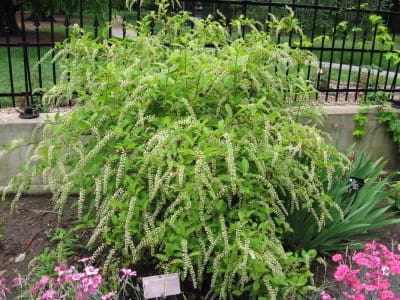Iteaceae
Virginia sweetspire
Itea virginica
Synonyms
Diconangia heterophyla
Itea padifolia
Itea virginica f. abbreviata
Other Common Names
Virginia-willow, tassel-white
Plant Type
Shrub (less than 10 ft)
Life Cycle
Perennial
Typical Size
4-8 ft. tall
3-6 ft. wide
Tolerant of
Deer, Occasional Flooding
Inolerant of
Dry Soil
Propagation
By seed, By cutting
Plant Propagation Notes
Semi-hardwood cuttings taken in late summer or early fall. Sow seeds thinly in flats; no pretreatment required.
Plant Planting Notes
The species is difficult to source. The cultivar ‘Henry’s Garnet’, which is a compact variety, is the most commonly sold.
Plants/Diseases
Resistant to Phytophthora root rot.
Wildlife Benefits
Nectar/pollen source for pollinating insects, Fruit/seeds for birds
Leaves
Leaf blade elliptic to oblong with serrate or minutely denticulate margins. Alternate.
Flowers
The small, less than 1 inch white flowers are arranged on a raceme. Fragrant.
Fruit
Woody, cylindric, and pubescent capsules
Bark
Stems are erect or arching, smooth or sparsely hairy. Bark is red/burgundy with crescent or C-shaped leaf scars.
Toxicity
No known toxicity.

USDA Hardiness Zones
5, 6, 7, 8, 9
Light Exposure
Part Sun/Shade
Soil Moisture
Moist
Soil Drainage
Well-drained
Soil pH
Neutral (6.0-8.0)
Native in South Carolina?
Yes
Plant Native Habitat
Swamps, wet woods, stream banks, streamheads, beaver ponds.
Global Conservation Status (NatureServe)
Apparently Secure (G4)
Federal Conservation Status (USFWS)
Not Listed
Distribution Notes
Common in the SC Coastal Plain and Piedmont and uncommon in the Mountains

